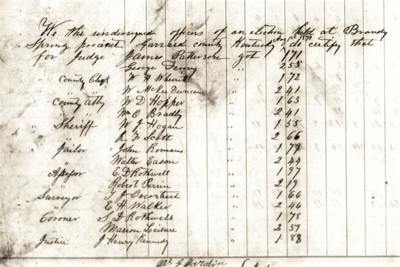

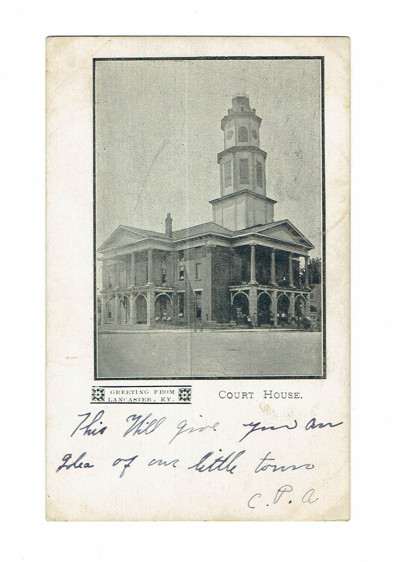
Postcard showing Lancaster Courthouse, built in 1868, out the front of which black men voted for the first time on August 1, 1870.
CourtHouseHistory.com; c1868-1914.
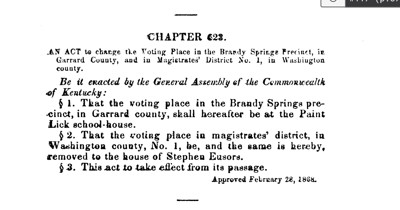
Polling locations were set by the Kentucky state legislature, including this 1868 law setting the Brandy Springs polling location at the Paint Lick school house.
Kentucky, Acts of the General Assembly of the Commonwealth of Kentucky., v.2 (1867/1868). HathiTrust Digital Library.
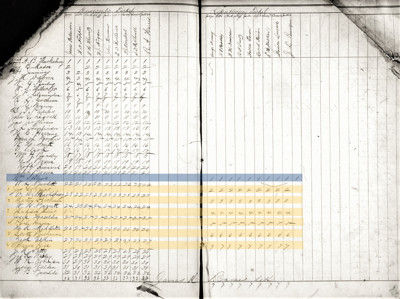
A page from the August 1870 Lancaster pollbook showing the first black voters (in yellow), led by Republican Party machine man, William Sellers (in blue). Note how the clerk, James K. Barnes, numbered each black voter.
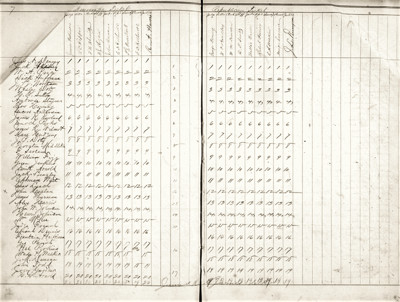
A page from the August 1870 Lancaster pollbook showing Republican and Democratic voters alternating. Note how the clerk, James K. Barnes, numbered each black voter in the center column, and that black voters make up 17 of the 19 Republican voters listed on the page.
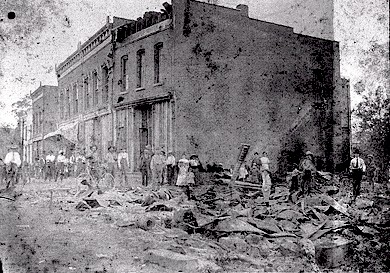
Photo of downtown Paint Lick in 1908, after a fire tore through the town.
Gordon McQuerry and Lyndon Irwin, http://lyndonirwin.com/.
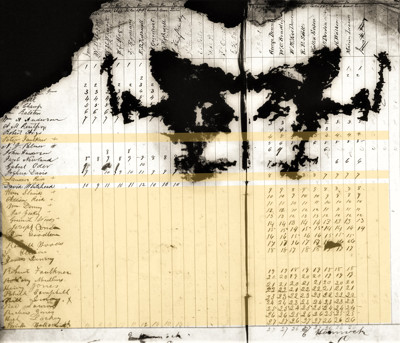
The first page of the (poorly preserved) August 1870 Brandy Springs pollbook showing the first black voters in Brandy Springs (in yellow). Note how the clerk, Ephraim Hammack, began numbering each black voter but soon gave up. Also note that black voters were allowed to vote as a group, and were not required to alternate like in Lancaster.
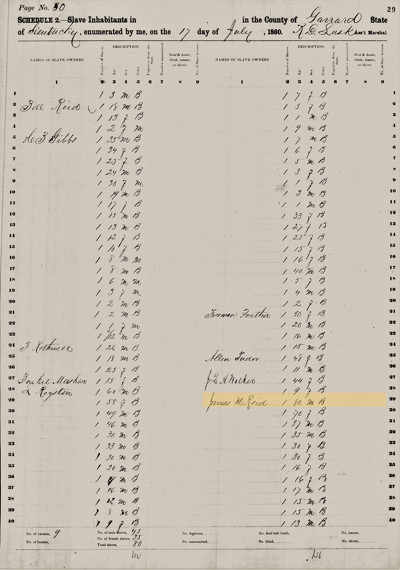
1860 U.S. Census slave schedule, showing the ages and sexes of people enslaved in Garrard County. Listed as Dr. James M. Reid’s property are 24 people, including an 80-year-old man who is almost certainly Saunders Reid.
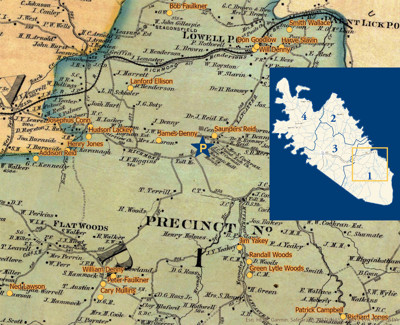
Edited detail from the 1879 Beers and Lanagan map, which shows where the first black voters in Brandy Springs lived in 1870 and the polling location (the star).
University of Wisconsin-Milwaukee Libraries.
The Political Revolution Arrives
African-American Men Arrive to Vote, August 1, 1870
Every two years, the eligible men of Garrard County turned out in the blazing August heat to vote on a laundry list of county offices. The county judge, the head of the executive in the county, was at the top of the ticket, followed by attorney, clerk, sheriff, jailor, assessor, surveyor, and coroner.
The county judge, attorney, clerk, and sheriff formed the center of county power, controlling the making and administration of justice in the county. Since the demise of the Whig party in the mid-1850s, these offices had always been won by Democrats.
But 1870 would be different.
On March 30, the 15th Amendment had become part of the US Constitution and black men became eligible to vote. Four months later this transformed electorate turned out to vote in Garrard County at the August 1, 1870, county election.
A New Generation of Republican Political Leaders
Two opposing tickets ran in this changed political landscape. The Democratic ticket was led by 60-year-old incumbent County Judge, James Patterson, who had served in county government from the early 1850s.
The Republican ticket was led by a team of up-and-coming novice politicians too young to have ever owned slaves themselves and only just old enough to vote. George Denny Jr., a 23-year-old “bold, forceful fellow who did not mince words,” ran for County Judge. 22-year-old “William O’Connell Bradley, a civil rights activist who would later serve as Governor of Kentucky and U.S. Senator, ran for County Attorney. William McKee Duncan, a 21-year-old lawyer, and Rueben F. Scott, a lieutenant in the Union Army in the Civil War, ran for County Clerk and Sheriff.
After more than a decade of Democratic rule, this youthful team of Republicans was able to take control of county government. They did so on the back of an alliance of first time African American voters and white Republicans.
Viva Voce Elections
Until late in 1891, local elections in Garrard County, as in the rest of Kentucky, were conducted “viva voce”—by voice.
In Lancaster precinct, one of the four Garrard voting precincts, the polling place was at the front of Lancaster’s new brick courthouse, probably on a platform constructed for the event. Not quite two years old, the courthouse was the pride of the town and the center of all intrigue and political maneuvering.
In the Brandy Springs precinct, the polling place was the Paint Lick schoolhouse, nestled in a small community near the geographic center of the precinct.
Under viva voce voting, each voter who came to the courthouse or schoolhouse declared aloud the candidates for whom he voted. Behind a table the clerk for the election watched each voter come forward, recorded each man’s name in his pollbook, and recorded the candidates for whom he voted. Next to him were two election judges, one Democrat, one Republican, who could challenge the eligibility of any voter. Roaming between the platform and the crowd of voters and spectators was the sheriff, charged with keeping the peace.
Most of those running the election—the clerk, election judges, and sheriff—would have been slave owners before the war. While there’s no way to know for sure, it’s likely that some of those who voted for the first time that day had been owned by those running the elections.
In order to vote, each and every black voter had to navigate their way through the assembled crowd, which no doubt included many confederate veterans, Ku Klux Klan supporters, former owners, and men generally hostile to African Americans voting, as well as the usual array of drunken and violent folk. They had to stand before the election clerk and audibly declare their vote, face any challenges to their vote, and make sure their vote was accurately recorded in the pollbook.
This was no trivial feat.
Pollbooks, painstakingly completed by election clerks from dawn to dusk, preserve these elections. Using the pollbooks, this story explores how the first election with enfranchised black men proceeded in Lancaster and Brandy Springs precincts.
From the pollbooks, we see how Republican partisans were closely monitoring black turnout. We see that African American men so threatened the existing political order that they were prevented from voting as a group in Lancaster. We also see that black men were the base of the Garrard County Republican Party, and that an alliance between black men and white Republicans forged the party’s path to victory in the county.
Polling Day in Lancaster
Barnes’ Pollbook
In the August 1, 1870, election in Lancaster precinct, James K. Barnes, a 22-year-old lawyer, was the clerk for the election. As a Republican clerking in candidate Bradley’s law offices, Barnes was likely deeply opposed to slavery, although he grew up on a plantation in Estill County. It is through his pollbook, an exhaustive and official tally of voters and votes, that we can re-create the excitement at the courthouse that day as 788 men came forward to vote.
The Polls Open in Lancaster Precinct
The Sheriff, John S. Slavins, a Democrat from a wealthy slave-owning family, declared the polls open at 6am. No doubt there would have been excitement in the air: everyone knew this election would differ from every past contest. This was history in the making.
Eventually.
The first 60 voters were white men, voting overwhelmingly for the Democratic ticket (55 to 5). These were the men that formed the commercial establishment of Lancaster town: merchants, hotel and bar keepers, and skilled craftsmen, including a tailor, druggist, surgeon, wagon maker, tinsmith, and jeweler. The town of Lancaster had only 82 business owners and 32 of them came forward in the initial early morning rush to vote for the Democratic ticket.
The First Black Voters Arrive
Then William R. Sellers, a Republican organizer and close friend of Denny’s, stepped forward as voter number 61, with 8 black men.
The revolution had arrived. Race invaded the voting procedure in a flash.
Sheriff Slavins had no doubt thought out his response to black voting. He immediately ordered all those waiting to organize themselves by party: Democrats here and Republicans there. They would alternate: one Democrat votes, then one Republican.
The logic of Slavins’ ploy was also to impose a racial penalty on white Republican voters. All Democratic voters were white; there were no black Democrats in Lancaster that day. But the Republicans were a mixture of black and white men. The white Republicans would either have to line up with African American men or abstain from voting until all black men had voted. Moreover, black voters would be sandwiched between white men, many of them Democrats.
In his pollbook, Barnes began numbering each black voter.
James Goggins had the distinction of being the first African American voter in Lancaster precinct. He declared his vote for the full Republican ticket. Another white man voted for the Democratic ticket, followed by Martin Hickman and, after another white Democrat, Madison Miller. After the next white Democrat came Phillip Dunn, a civil war veteran. Dunn had been enslaved by Benjamin F. Dunn. Phillip declared his vote for all the Republican candidates just as, later that day and in that same spot, his former owner voted for all the Democratic candidates. Former property and owner, they may have witnessed each other’s votes.
After the first group of black voters ever to declare their votes at the Lancaster courthouse had made their way off the platform, the tide of the election shifted—briefly—to the Democratic Party. Thirty white Democratic voters shouted out 30 straight ticket allegiances interspersed by only three Republican votes, each of them from a black man voting for the first time.
The poll equalized. Both parties rounded up their supporters. The votes alternated—a single white Democratic voter, then a single Republican voter—for hours. The next 515 votes, two thirds of the total votes cast at the courthouse that day, were cast in this pattern.
The Republicans’ Dependence on Black Voters
Republican hopes rested on black men: 73 percent of the Republican vote came from men who had been enslaved five years earlier. Republican organizers struggled to turn out the white men who had voted Republican in 1868.
Barnes’ numbering of black voters in the pollbook visually demonstrates just how heavily the party relied on them. Page seven of the pollbook (left), shows that of 19 Republican votes on the page, 17 came from newly enfranchised black men. This pattern continued page after page.
The party machine, keeping track as they were, would have been alarmed.
Around 35% of eligible men in Lancaster precinct were black. Black turnout seemed quite high, with black voters making up about 40% of all voters for most of the day. However, even with high African American turnout, a Republican Party victory would be impossible without substantial support among white voters.
And then, toward the end of the day, the black vote was exhausted. Among the last 224 voters, only 30 more black men came forward. The Republican Party needed to persuade a mass of white men to vote for its ticket if they were to have any chance of victory.
White Republicans Finally Turn out
Perhaps Barnes, Denny, and other members of the Republican machine identified their overreliance on African American voters and determinedly mobilized known white Republicans. Alternatively, it may have been that Slavins’ strategy, of forcing white to line up with black, had worked in deterring white Republicans from the polls until the black men had left. Whatever it was, the bulk of the white Republican vote came in the final hours of the poll: 69 of the total 95 white Republican votes.
Barnes announced the last vote of the day, his own, for the Republican ticket. He tallied up the figures across the 21 pages of his Lancaster pollbook.
It wasn’t good for the Republican Party.
Democratic candidates had a lead of about 100 votes over the Republicans for each office being contested.
The overall result would depend on three smaller and more rural precincts, including Brandy Springs. If Republicans scored large victories there, they might be able to win the county and take control of county government.
Polling Day in Brandy Springs
Hammack’s Pollbook
In the Brandy Springs precinct, we can observe the days polling through Ephraim Hammack’s pollbook. Hammack, 35, was a schoolteacher at the Paint Lick schoolhouse, where the election was taking place, and a Republican. His pollbook is less well-preserved than the one in Lancaster precinct, but we can still learn a good deal from it.
Black Voters Arrive Early
In Brandy Springs, it didn’t take long for the revolution to arrive. The 12th voter of the day, Peter Faulkner, was a black man. Fifty-three years old and a farm laborer, he was a close neighbor of Hammack, and perhaps was emboldened by a familiar face to vote early. Hammack noted this first black vote with a cross in his poll book.
A few voters later, a group of at least 20 black men declared their votes. Unlike voters following Slavins’ directions in Lancaster, these black men were allowed to vote together. Black voters were so numerous that Hammack soon gave up marking them in his pollbook.
Saunders Reid, at the head of the group, was the 18th voter of the day. A very old man, in the 1870 Census he is listed as being 100 years old (although the 1860 Census slave schedule records his age as 80). Saunders Reid lived just down the road from the polling place, on the edge of the property of his former owner, Dr. James Reid.
Connections Among New Voters
There were many links among the group of first-time voters. New free neighbors; former plantation cohabitants; and men who served together in the military.
Reflecting the agricultural nature of the precinct, all in that first group of 20 black voters were common laborers or farmworkers, according to the 1870 Census. They were mostly young men in their 20s, 30s, and 40s, with Peter Faulkner (53) and Saunders Reid (100) standing out for their more advanced age.
Peter Faulkner, the first black voter of the day, was a neighbor of William Denny and Cary Mullins, both of whom voted together in the first large group of black men. Cary Mullins served in Company D of the 12th Heavy Artillery with Bob Faulkner. Bob and Peter probably lived in slavery together as property of John W. Walker. Ned Lawson, another voter in the group, lived with Mullins by 1880.
Saunders Reid voted next to Addison Reid (aged 26), with whom he had been enslaved: perhaps his son, nephew, or grandson. Addison Reid lived a few doors down from Henry Jones, who voted with the group. Henry Jones may have been enslaved with Richard Jones, another voter in the group, and they might also be related. Richard Jones lived with Patrick Campbell, who voted in that same group of 20. These five black men who were neighbors or had shared a life of slavery now traveled together in freedom to the schoolhouse to vote together for the Republican ticket.
Black Men Voting in Front of their Former Owners
Peter and Bob Faulkners former owner was John W. Walker. Peter was the 12th voter of the day, Bob, the 30th. But John Walker, who voted 103rd, was very likely there in the schoolhouse crowd to see and hear his two former slaves vote Republican, while he later declared his vote for Democrats.
Jim Yakey’s former owner, John Y. Yakey, on whose property Jim still lived, voted a few hours later (134th of 432 voters) for the Democratic ticket. He probably heard Jim’s vote, cast as the 23rd voice that day.
Cary Mullins’ former owners, Benjamin G. and John W. Mullins, also voted that day, for the Democrats. Likewise, Saunders and Addison Reid’s owner, Dr. James M. Reed, voted later in the day (the 304th voter of the day). Dr. Reed also declared his vote for the Democratic Party candidates.
The former slaves were certainly not politically loyal to their former owners, and they said so, aloud, in their presence.
A rare exception to former owner and former slave voting opposite was the case of the Dennys. James and William Denny were likely formerly owned by candidate George Denny’s father, Alexander Finley (A.F.) Denny. A.F. Denny voted, like his two former slaves, for the Republican revolution led by his son.
Interestingly, one of the few Garrard County black men who were free in 1860 voted in Brandy Springs that day, for the Republican ticket. Newton Woods, a blacksmith by trade, actually owned 3 people in 1860. These people were likely members of his extended family, with whom he lived just down the road from A.F. Denny.
Like the many recently freed black men among whom he voted, 1870 was the first election in which Woods could vote. He was the 124th voter of the day, casting a ballot for the Republican ticket. He voted with another one of A. F. Denny’s former slaves, Isaac Denny (voter number 125).
The Republican Machine Turns out Black Men
At the end of the day, after Clerk Hammack declared his vote, George Denny received 255 (59%) of the 432 votes cast in Brandy Springs precinct. Republicans turned out 116 black men, making up 27% of the total electorate that day and 46% of the total vote for Denny. Critically the Republican ticket garnered significant support from white men (which had not been the case in Lancaster). This performance, repeated in the two other more rural precincts, Buckeye and Bryantsville, was enough to ensure Denny and all but one of the Republican candidates a stunning electoral victory.
The 1870 election, a Republican disaster in the courthouse town of Lancaster, became a Republican victory at the county level because black and white men voted together.
Black voters were not enough on their own to ensure a Republican victory and neither were white Republican voters. The Republicans prevailed only as a cross-racial coalition. For the next 30 years, the Republican machine was the dominant political force of Garrard County, able to win victory by turning out black and white voters.


